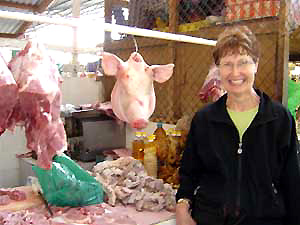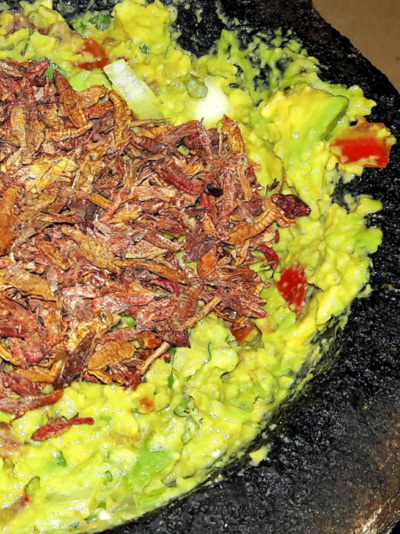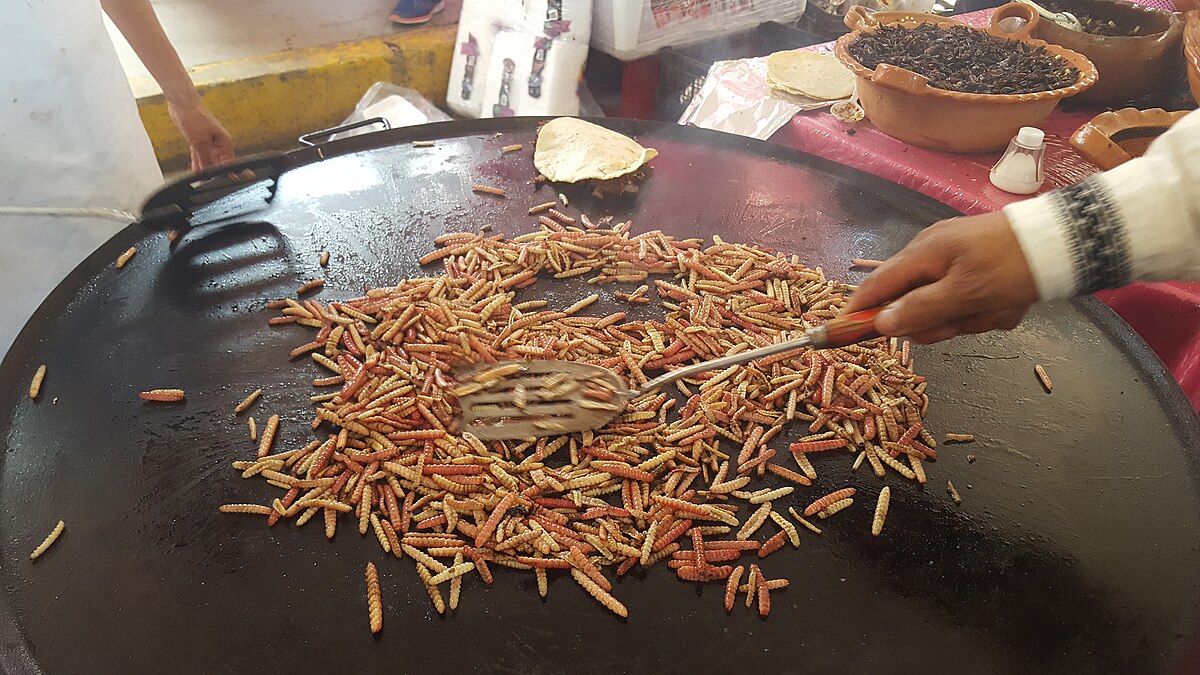 Meat stall in a mercado about an hour outside Villahermosa, Tabasco, Mexico. Photo of and by Cherry Bedenkop of Arizona
Meat stall in a mercado about an hour outside Villahermosa, Tabasco, Mexico. Photo of and by Cherry Bedenkop of ArizonaIn the mercado's meat stalls, besides the usual cuts, one can spot many states of ground-up and pasted flesh, with local specialties based on unique seasoning, fat content, packaging, etc. On the very busy road between Mexico City and Toluca, often people sell a sort of green sausage from the trunks of their cars -- right next to house-size signs sponsored by the government warning people, for health reasons, not to buy meats from roadside vendors. The same green sausage is found in many mercados in central Mexico.
Above you see strips of drying meat in a small town in upland Chiapas. The strips are cut from between the ribs, the fat parts of the legs, and elsewhere, salted, and hung to dry for a day or two. That way the meat keeps for several weeks without refrigeration. Around Pantepec this is called tafajo, but it has other names in other regions. Such items often show up in traditional mercados. It's sold by the "cuarta" (span of a hand) for about five pesos, or by the kilo. When someone wants to use the tafajo, the meat is washed, then cut into small pieces and added to beans and other typical dishes.
Of course ancient indigenous Mexicans had deer and peccaries (a kind of wild pig) to eat, as well as a tremendous assortment of smaller mammals, wild ducks and geese, fish, and other wildlife. Occasionally these still appear in mercados.
 Part of a picture of guacamole con chapulines, or "guacamole with grasshoppers" prepared in a traditional black, stone mortar, or molcajete; copyright-free image courtesy of Miguel Angel Omaña Rojas made available through Wikimedia Commons.
Part of a picture of guacamole con chapulines, or "guacamole with grasshoppers" prepared in a traditional black, stone mortar, or molcajete; copyright-free image courtesy of Miguel Angel Omaña Rojas made available through Wikimedia Commons.One commonly encountered, high-protein mercado dish frequently sold in small pans and looking like heaps of moist, orangish shreds of chewing tobacco, as seen at the left, deserves special mention. If you tasted this dish and someone told you that it was marinated, shredded jerked beef, you might believe it -- until tiny legs began sticking between your teeth. Here you're eating chapulines, or small grasshoppers. Often chapulín vendors also sell bags of greens and herbs specially blended for preparing a kind of chapulín salad.
Other insects are still eaten in the hinterlands, but they are less conspicuous at mercados. If present at all, they will probably be heaped in a straw canister on a sidewalk next to an indigenous lady. In the uplands of southern Mexico sometimes toasted ants, called chicatanas, are eaten, as well as cicadas, called chicharras. A certain species of dragonfly produces a black larva called caballito del diablo (Devil's horse), from which the hard mouthparts are removed, and then the rest is eaten alive, toasted on the comal, or fried in oil or grease. In the Mixtec highlands, aquatic cucarachones de agua (big water-cockroaches), and chinch bugs are often preserved in salt. Wasp nests full of larvae are roasted in many localities.
 Chinicuiles (maguey worms) being toasted on a comal at the XXXVIII Gastronomical fair of Santiago de Anaya, in the state of Hidalgo; copyright-free image courtesy of "MCGau" made available through Wikimedia Commons.
Chinicuiles (maguey worms) being toasted on a comal at the XXXVIII Gastronomical fair of Santiago de Anaya, in the state of Hidalgo; copyright-free image courtesy of "MCGau" made available through Wikimedia Commons.In the central highlands, maguey (the so-called century plant, an agave) is home to two species of edible worm, the chinicuiles and the meocuiles, red and white worms, respectively. Chinicuiles are larvae of a moth available only in rainy September and early October, when they abound in the roots and hearts of magueys. Their tastes impregnate a salsa when added entire. Also they are eaten fried with onion and green chili, and wrapped in hot tortillas. The rather meaty, white meocuiles are butterfly larvae living in galleries excavated in maguey leaves. In May they are fried in their own grease or in lard, and eaten in tacos; some say the taste is similar to chicharrón, or pig crackling. A kind of large, edible grub is still rarely harvested from oak and madrone trees.
In fact, just about any large grub of any butterfly, moth, or beetle is fair game for frying and putting into tacos.